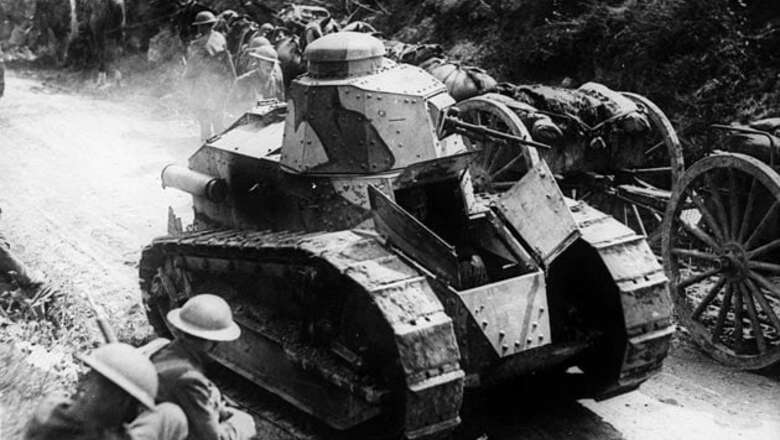
views
Paris: The Great War pulled in close to 70 million soldiers on five continents, leaving some 10 million dead in battle and claiming many million more lives through hunger and disease.
The 1914-18 conflict toppled four empires, Austro-Hungarian, German, Ottoman and Russian, redrawing the world map and shaping the geopolitics of the coming century.
Here is a timeline of the war:
1914
June 28: Archduke Franz-Ferdinand, heir to the Austro-Hungarian throne, is assassinated by a pro-Serb nationalist in Sarajevo.
July 28: Austria-Hungary declares war on Serbia. Russia mobilises two days later in aid of its Serbian ally, setting off a chain reaction among European powers bound by a web of military alliances.
August 1: Both France and Germany declare general mobilisations, Germany declares war on Russia.
August 3: Germany declares war on France, German troops invade neutral Belgium.
August 4: Britain declares war on Germany, joins France, Russia in group known as the Allies.
August 19-24: Clashes along the borders between France and Belgium, and France and Germany push French back 200 kilometres (125 miles) before they dig in on the banks of the Marne River.
August 22 is the worst day of the war for France as 27,000 troops die.
August 23: Japan declares war on Germany.
August 26-30: Battle of Tannenberg. German General Paul von Hindenburg halts Russian breakthrough in Prussia.
September 6-9: First battle of the Marne. Franco-British force of almost one million troops stops 800,000 German soldiers less than 40 kilometres from Paris, then recovers some ground.
September-November: "Race to the sea" on the Western Front. Each side tries to outflank the other, fighting creeps north, reaches North Sea on November 17.
A front now extends from the coast to Switzerland, barely to shift until 1918 as troops dig vast trench networks cutting through northeast France. Lines on the Eastern Front are more fluid.
November 1: The Ottoman Empire blocks Black Sea access, isolates Russia and joins Austria-Hungary and Germany in a group known as the Central Powers.
1915
January 19: First Zeppelin raid on Britain.
March 18 - December: Allied campaign in the Dardanelles region of the Ottoman Empire aimed at helping Russia is a failure.
On April 25, troops from Australia, Britain, France and New Zealand attempt landing near Gallipoli but are driven back by the Ottomans.
The Allies lose 180,000 soldiers, Ottoman losses are put at 66,000.
Last Allied troops are evacuated on January 9, 1916 and the southern European front is frozen until late 1917.
April 22: Germans launch first poison gas attack against Canadian and French soldiers near Ypres.
April 24: Arrest and massacre of Armenians in Istanbul, then called Constantinople. Start of a genocide that lasts into 1917 and kills more than 1.5 million people according to Armenian sources. Turkish authorities put toll at 250,000-500,000.
May 7: British ocean liner Lusitania is sunk by a German submarine off the coast of Ireland, leaving 1,198 people missing, including 128 US citizens, and provoking outrage in western democracies.
May 23: Italy joins the war on the Allied side.
October 5: Allied expeditionary force lands in Salonica, Greece. Bulgaria joins the Central Powers.
1916
January 27: Conscription introduced in Britain.
February 21: Battle of Verdun begins with a German offensive but the French contain a breakthrough. Fierce fighting that lasts until June, claiming the lives of 500,000 soldiers in all. The battles becomes a symbol of the war for the French.
March 9: Secret Sykes-Picot Agreement establishes British and French zones of influence in the Middle East.
June 7: Arab revolt against the Ottoman Empire begins with help from Britain.
July 1: Battle of the Somme, the war's biggest, begins. More than three million soldiers take part to November 18.
British forces introduce tanks on September 15. Overall casualties total 1.2 million troops.
For Britain and Germany, the Somme becomes the symbol of the war.
1917
February 1: Germany launches all-out submarine attacks against Atlantic shipping. The United States cuts diplomatic ties with Berlin.
March 8-15: The first Russian Revolution topples Czar Nicolas II.
April 6: The United States declares war on Germany.
April 16-May 9: A French offensive at Chemin des Dames in the Champagne region fails, killing several tens of thousands in a few days. Some French soldiers mutiny.
In September, British forces mutiny in the coastal town of Etaples, and German sailors refuse to embark on what they consider a suicide mission from Kiel in late October 1918.
November 5-6: Second Russian revolution, also called October Revolution owing to Russian use of the Julian calendar, brings Vladimir Lenin and the Bolshevik party to power.
December 9: British forces enter Jerusalem, a month after the Balfour declaration backs the establishment of a Jewish homeland in Palestine.
December 15: Russia and Central Powers sign Brest-Litovsk armistice, follow with a peace treaty on March 3, 1918.
1918
January 8: United States spells out its goals in a statement known as the Fourteen Points that presage post-war treaties.
US intervention takes effect in the spring of 1918, helps end the war.
March 21: German forces launch first of several offensives on the Western Front to claim victory before US reinforcements arrive. Allied troops struggle but hold their positions.
July 15: Second Battle of the Marne. Allies stage a counteroffensive at Viller-Cotterets with fresh US troops. German forces are pushed back and begin a long retreat.
Allies also advance in Asia and the Balkans.
September/November: Peak of Spanish flu epidemic that kills at least 20 million people across Europe in two years.
October 30: Ottoman Empire signs an armistice, Austria-Hungary follows on November 3.
November 9: German emperor Wilhelm II abdicates. Demonstrations break out in Berlin.
November 11: Allied Victory. Armistice with Germany takes effect at 11:00 am.




















Comments
0 comment